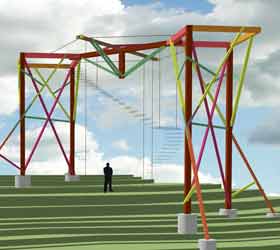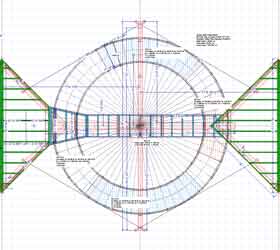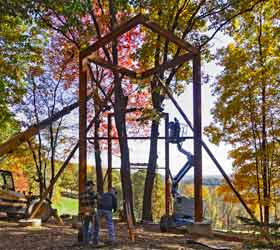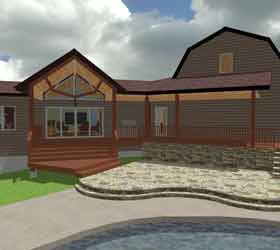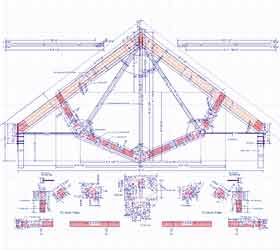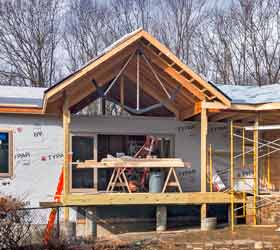What is Design & Build?
Design & Build is an integrated construction process that leverages a combined team of builders and designers to streamline communication, increase workflow and find solutions to complex and detail oriented projects. Ultimately, we believe the gains in efficiency and flexibility result in buildings of the highest quality at the lowest cost.
Our Philosophy
We believe that the spaces we inhabit have a profound effect on us and that well-crafted space can have a subtle but dramatic impact on how we experience the world. As artists we have a deep interest in developing creative solutions that interweave the unique circumstances of each project into a unified vision. Often working closely with our clients, we focus on understanding their individual dreams and developing real down to earth solutions for achieving them. We see the buildings we create as not just a mechanical list of square foot areas and features, but as living creatures imbued with our client’s feeling and personality. We have come to find that good design is a constant process of adaptation and we are constantly looking for ways of achieving a better fit.
As hands on craftsmen engaged daily in the details of building, we have a deep respect for the environment and the material we work with, and we feel that this is critical to producing honest and economical buildings. This practical and intuitive construction experience provides a strong foundation that is essential for exploring unique and creative design solutions.
Too often, the process of building is fragmented and disconnected both in terms of the initial conception and planning and in the act of building itself. The traditional design-bid-build construction model, where the act of design is separate from the act of building, often produces a process that places architects and builders at odds and leaves the owner caught in the middle. In this model, the architect is separate from the actual construction work and is required to produce a detailed set of plans for bid by a general contractor. The general contractor is in turn focused primarily on cost and schedule and takes little responsibility for the overall design and character of the project.
While architects are generally knowledgeable of code requirements and can produce beautifully detailed technical drawings, they often lack intuitive “hands on” knowledge of construction and a detailed understanding of the practical cost implications of their design decisions. As a result, the architectural design process is typically afraid to look beyond the narrow confines of accepted practice and is bound by the need to create highly detailed drawings and specifications in order to maintain control and provide a fair bid. This high level of drawing and specification is an involved process that requires a substantial investment, often with little guarantee that the project can be accomplished for the proposed budget. It is also a process with limited flexibility that is slow to adapt to conditions in the field once a bid has been accepted. The resultant change orders are time consuming and expensive.
On the other side, this model tends towards general contractors that have limited vision. The bidding process is by design competitive and forces the general contractor, if he wishes to get the job, to focus on economy and schedule at the expense of all else. Since his initial investment in the project is based primarily on cost, this process encourages an atmosphere in which he is constantly looking to cut corners and offer cheaper substitutes while ignoring the nuances of spirit, feeling, craftsmanship and overall value in the buildings he creates. Often this is taken to extremes in developments where virtually identical homes are cheaply mass produced. While the square foot features and prices of these buildings can be attractive, their lack of identity and sensitivity to context severely limit their potential. Often these buildings are plagued by chronic maintenance issues and unresolvable tensions that stem for poor construction practices and a myopic disregard for the overall longevity of the building.
It’s not to say that a construction model of independent designers and builders is incapable of working. Generally it has been our experience that it’s far from perfect, and works best when builders and designers mutually trust and respect each other.
Design+Build Advantages
There are many advantages to Design & Build. We find the following to be some of the most compelling.
Design & Build provides one point of responsibility that decreases the stress of managing multiple parties and places focus on overall integrity and value. Having one entity responsible for all facets of the project provides a strong incentive to get things right from the beginning. Realistic assessments of cost and budget are brought to bear in the initial stages of design, and emphasis is placed on accounting for all the features required to get the job done, so there are no big surprises at the end.
Design and Build sets the stage for greater client input and participation. Having designers and builders intimately invloved in the whole project, enhances communication and allows for greater attention to detail; insuring your project is built the way you want and that important details are not lost in the translation between multiple parites.
Having an experienced builder’s perspective in the initial stages of design can be invaluable. It allows for well grounded plans informed by an in depth knowledge of building technique and material and works to contain design ideas to the scope of the budget. The added insight offers a value orientated approach from square one. This firm grounding also allows space for exploring more creative and ambitious design solutions, and provides an opportunity to create highly customized buildings without extravagant design and administrative cost.
Having everyone on the same team and working together on a common set of goals encourages an atmosphere of communication, adaptation and innovation. When complications arise, instead of excuses & blame, the only recourse is to work together to find solutions.
The increased continuity of a single streamlined workflow boosts efficiency and decreases cost.
Design and Build allows for greater adaptability and flexibility. While there is always added time and cost in changes made during construction, having both designers and builders involved from the start, makes modifications as painless as possible while safeguarding the integrity of the project. Often a client decides to make a change based on new information, or there are fluctuations with material availability, or new conditions are uncovered in the field. Having one entity responsible for the complete project increases efficacy and allows for quick response to the uncertainties of construction.
In the end, we believe the bottom line advantages of Design & Build translate into greater customization and control, increased quality and reduced cost.
